Chemical Reactor Temperature Control System – LNEYA
The working principle, control mode, and detailed working conditions of the chemical reactor temperature control system can be customized. According to user requirements, the reasonable matching between low temperature and cooling capacity, low temperature and container capacity can meet the actual needs of different users. The main function of the temperature control system of the reactor is to dynamically control the temperature of the reactor, improve the heat transfer efficiency, meet the strict requirements of high process standards, close-cycle heating, small heat loss, and a wide range of applications.
Principle of chemical reactor temperature control system
In the chemical industry, the reactor is the key to the entire chemical process, and cooling has become a necessary condition for the reaction, which is related to the production quality of the entire finished product. The temperature control system of the reactor is selected by the cooling coil, which is equipped with cooling inlet and outlet, cooling water, refrigerant and external circulating coolant.
Regarding the orientation of the device for the cooling coil, the device is usually inside the reactor to reduce the temperature of the material in the reaction, and it can be placed outside when the material is highly viscous or the coil requires a mixed mode: in the case where the medium is used as a heat source for heating, the cooling The coil can be placed in the medium, and the heating of the resistance wire depends on the specific situation, but the heating effect and cooling effect should be considered.
The chemical reactor temperature control system adopts high-intelligence PLC and PC-level microcomputer control system, which can be operated remotely. It has timing switch and failure analysis, real-time recording and display of data, and drawing of curves. The data is automatically saved.
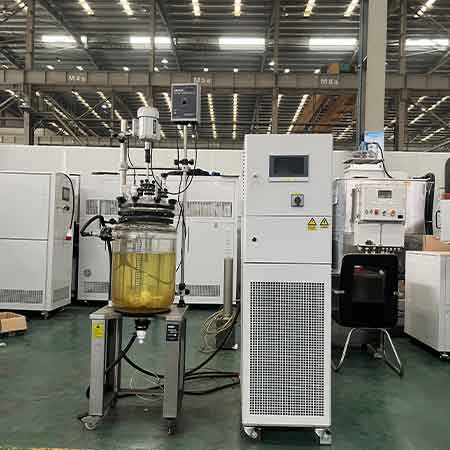
Control method of chemical reactor temperature control system
(1) Temperature control method: Temperature control methods can be divided into position control, proportional control, proportional integral control, proportional differential control, proportional integral differential control, computer intelligent control such as PLC, online non-contact temperature control, etc.
(2) Bit-type control: Bit-type control means that when the given temperature is higher than the set value, the heater is turned off, and when the lower limit temperature is lower than the set value, the heater is turned on. The temperature is always within a certain range, and the bit The control system is simple and reliable, and is generally used in conduction or convection heating occasions.
(3) Cascade control: Position control and proportional control When the load changes greatly, its temperature is difficult to maintain at the set value. To achieve this goal, we can add one or more sensors. When the temperature has not changed, the power can be adjusted in time to ensure the stability of the temperature.
(4) Online non-contact temperature control: This control method is mainly used in other occasions such as online detection and control of the process temperature of moving objects (such as online control of the working temperature of rolling objects and displacement objects).
Working condition selection of chemical reactor temperature control system
1. Select the circulation pump model according to the required coolant volume. Of course, the larger the capacity and the lower the temperature, the higher the price.
2. According to the different temperature required by the experiment, choose the cryopump with the corresponding temperature control range. The lower the temperature, the higher the price of the pump, and the low temperature of chemical reactor temperature control system can reach -120℃.
3. Whether the test solution is corrosive, if it is a strong acid or alkali solution, you need to purchase a corrosion-resistant reactor temperature control system.
Sistemas dinámicos de control de la temperatura (soporte de personalización)

Sistemas de refrigeración y calefacción (serie SUNDI) (Diseños a medida)
Rango de control de temperatura: -120°C a +350°C
Application: Various Reactors (Microchannels, Glass, Jacketed Reactors, etc.), Distillation or Extraction System, Laboratory, University, Research Institute, Aerospace, Automotive Industry, Semiconductor and Electrical Test, Chemical, Pharmaceutical, Petrochemical, Biochemical, Medical, Hospital, R&D Workshop, Aerospace, Biological and Other Industries.
| Temperatura | Serie -10 ~ +150°C | Serie -25 ~ +200°C | Serie -25 ~ +300°C | Serie -45 ~ +250°C | Serie -45 ~ +300°C | Serie -60 ~ +250°C | Serie -60 ~ +300°C | Serie -70 ~ +250°C | Serie -80 ~ +250°C | Serie -90 ~ +250°C | Serie -100 ~ +100°C | -25 ~ +200°C una máquina para dos reactores | -40 ~ +200°C una máquina para dos reactores |
| Capacidad de refrigeración | 1,5 ~ 15 kW | 1 ~ 200 kW | 1 ~ 200 kW | 0,45 ~ 200 kW | 0,9 ~ 25 kW | 0,25 ~ 60 kW | 0,75 ~ 25 kW | 0,4 ~ 15 kW | 0,3 ~ 80 kW | 0,2 ~ 80 kW | 0,45 ~ 80 kW | hasta 10*2 kW | hasta 10*2 kW |
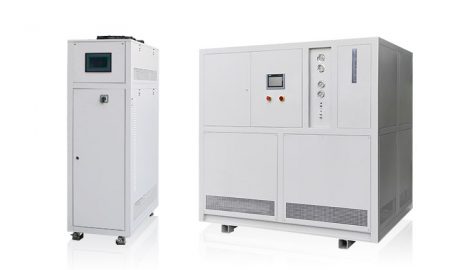
Sistemas de refrigeración y calefacción (serie WTD) (Diseños a medida)
(Microcanales / reactores tubulares especializados)
Rango de control de temperatura: de -70°C a +300°C
Diseño especializado para microcanal (pequeña capacidad de retención de líquido, gran capacidad de intercambio de calor, sistema de circulación de alta caída de presión)
| Temperatura | -70°C ~ +300°C | -45°C ~ +250°C | -70°C ~ +200°C |
| Capacidad de refrigeración | 1,1 ~ 7,5 kW | 1,5 ~ 5,5 kW | 11 ~ 50kW |
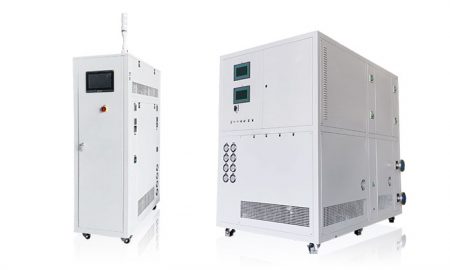
Cooling and Heating Systems (TES series) (Diseños a medida)
Temperature Control Range: -85°C ~ +250°C
Temp Control Accuracy: ± 0.3°C
| Temperatura | Serie -45°C ~ +250°C | Serie -85°C ~ +200°C | Serie -60°C ~ +200°C |
| Capacidad de refrigeración | 0,3 ~ 25 kW | 0,25 ~ 25 kW | 3 ~ 60kW |

Cooling and Heating Machines (LTS series) (Diseños a medida)
Temperature Control Range: -80°C to +80°C
It is widely used in the semiconductor process to control the temperature of the reaction chamber, the hot sink plate and the non-flammable heat transfer medium.
| Temperatura | Serie -20°C ~ +80°C | Serie -45°C ~ +80°C | Serie -60°C ~ +80°C | Serie -80°C ~ +80°C |
| Control de caudal | 7 ~ 45 L/min | 7 ~ 45 L/min | 7 ~ 45 L/min | 7 ~ 45 L/min |

Circuladores de refrigeración y calefacción (Diseños a medida)
Rango de control de temperatura: -45°C a +250°C
Application: Various Reactors (Microchannels, Glass, Jacketed Reactors, etc.), Distillation or Extraction System, Laboratory, University, Research Institute, Aerospace, Chemical, Pharmaceutical, Petrochemical, Biochemical, Medical, Hospital, R&D Workshop, Aerospace, Biological and Other Industries.
| Temperatura | Serie -25°C ~ +200°C | Serie -45°C ~ +250°C |
| Capacidad de refrigeración | 1 ~ 15 kW | 0,25 ~ 15 kW |
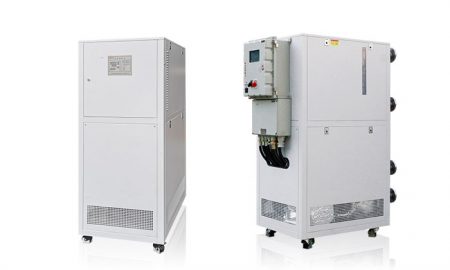
Termostatos de circulación (Diseños a medida)
Rango de control de temperatura: +50°C a +300°C
Nota: La serie UC puede controlar la temperatura del medio de transferencia de calor. La serie UST no solo puede controlar la temperatura del medio de transferencia de calor, sino también la temperatura del material de reacción.
| Temperatura | +50°C ~ +170°C (serie UC) | +50°C ~ +300°C (serie UC) | +50°C ~ +300°C (serie UST) |
| Capacidad de calefacción | 5,5 ~ 15 kW | 3,5 ~ 130 kW | 3,5 ~ 95 kW |
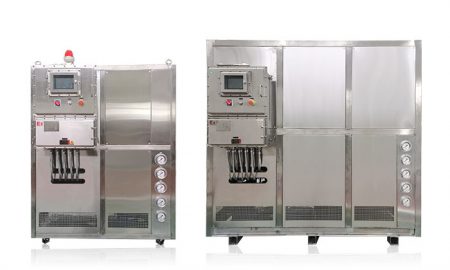
TCU Sistema de control de temperatura multirreactores (Diseños a medida)
Rango de control de temperatura: -120°C a +250°C
Application: Various Reactors (Microchannels, Glass, Jacketed Reactors, etc.), Distillation or Extraction System, Laboratory, University, Research Institute, Aerospace, Chemical, Pharmaceutical, Petrochemical, Biochemical, Medical, Hospital, R&D Workshop, Aerospace, Biological and Other Industries.
| Temperatura | Serie -45°C ~ +250°C | Serie -120°C ~ +250°C | Sistema de control de temperatura personalizado | RT+10°C ~ +135°C |
| Capacidad de calefacción | 25 ~ 80 kW | 25 ~ 80 kW | A medida | 25 ~ 300 kW |
 LNEYA
LNEYA
 简体中文
简体中文

















































































